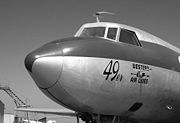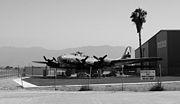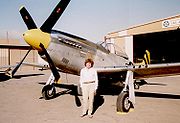
Planes of Fame
Encyclopedia

Aviation
Aviation is the design, development, production, operation, and use of aircraft, especially heavier-than-air aircraft. Aviation is derived from avis, the Latin word for bird.-History:...
museum located in Chino
Chino, California
Chino is a city in San Bernardino County, California, United States. It is located in the western end of the Riverside-San Bernardino Area and it is easily accessible via the Chino Valley and Pomona freeways....
, California
California
California is a state located on the West Coast of the United States. It is by far the most populous U.S. state, and the third-largest by land area...
, and Valle
Valle, Arizona
Valle is an unincorporated community in Coconino County, Arizona, United States. It lies at , at an altitude of 5,994 feet , at the junction of U.S. Route 180 and State Route 64. Its attractions include the Valle Airport , the Planes of Fame Air Museum, and Flintstones Bedrock City...
, Arizona
Arizona
Arizona ; is a state located in the southwestern region of the United States. It is also part of the western United States and the mountain west. The capital and largest city is Phoenix...
. The museum has many flying and static aircraft, along with multiple rare examples under restoration.
History
Planes of Fame Air Museum was founded by Edward T. MaloneyEdward T. Maloney
Edward T. Maloney is an aviation historian and museum curator based in Southern California.He is responsible for building much of the collection of historic airframes displayed at the Planes of Fame Museum at Chino Airport, Chino, California....
in Claremont, California
Claremont, California
Claremont is a small affluent college town in eastern Los Angeles County, California, United States, about east of downtown Los Angeles at the base of the San Gabriel Mountains. The population as of the 2010 census is 34,926. Claremont is known for its seven higher-education institutions, its...
, January 12, 1957. At that time, it was called "The Air Museum". A small group of volunteers, including future Museum president Steve Hinton
Steve Hinton
Steve Hinton is an American aviator who held a world speed record from 1979–1989 and won six Unlimited air races including two national championships. He won four consecutive Unlimited races in one year, and remains the only pilot ever to do so. He retired from racing in 1990...
, set out to make the aircraft that had barely been saved from the smelters, flyable.
As the Museum's collection of aircraft and memorabilia continued to grow, it became necessary to find a new home with enough space to house them. In 1962, the museum relocated to nearby Ontario Airport, Ontario, California.
A few years later, in 1970, redevelopment of the airport at Ontario forced The Air Museum to move. The non-flyable aircraft became part of the "Movie World: Cars of the Stars and Planes of Fame Museum" in Buena Park, California, located near Knott's Berry Farm
Knott's Berry Farm
Knott's Berry Farm is a theme park in Buena Park, California, now owned by Cedar Fair Entertainment Company, and a line of jams, jellies, preserves, and other specialty food, now part of The J. M. Smucker Company based in Placentia, California....
, while the flyable aircraft relocated to Chino Airport
Chino Airport
Chino Airport is a county-owned public-use airport located about three miles southeast of Chino, a town in San Bernardino County, California...
, about 30 miles (48 km) away. When Movie World closed, the name "Planes of Fame" stayed.
Planes of Fame consolidated in 1973, with its static aircraft joining the flying ones at historic Chino Airport in Chino, California. This was fitting as the airport was formerly the home of Cal-Aero Academy, which was an Army Air Corp flight training facility. The academy trained over 10,000 pilots prior to the end of World War II
World War II
World War II, or the Second World War , was a global conflict lasting from 1939 to 1945, involving most of the world's nations—including all of the great powers—eventually forming two opposing military alliances: the Allies and the Axis...
, making it a perfect location in which to restore and give new life to the aircraft these men had flown into combat just two decades earlier. As more and more aircraft were restored and the collection grew, an additional display facility was opened in Valle, Arizona
Valle, Arizona
Valle is an unincorporated community in Coconino County, Arizona, United States. It lies at , at an altitude of 5,994 feet , at the junction of U.S. Route 180 and State Route 64. Its attractions include the Valle Airport , the Planes of Fame Air Museum, and Flintstones Bedrock City...
in 1995. Located halfway between Williams, Arizona
Williams, Arizona
Williams is a city in Coconino County, Arizona, United States west of Flagstaff. Its population was 2,842 at the 2000 census; according to 2006 Census Bureau estimates, the population of the city is 3,094. It lies on the route of Historic Route 66, Interstate 40, and the Southwest Chief Amtrak...
and the south rim of the Grand Canyon, it houses over 40 of the Museum’s aircraft, many of which are also flyable.
Growth continued at Chino, too. In 2002, the Enterprise Hangar was opened. Designed to resemble the hangar deck of a World War II Navy aircraft carrier, it contains a number of items from the USS Enterprise (CV-6)
USS Enterprise (CV-6)
USS Enterprise , colloquially referred to as the "Big E," was the sixth aircraft carrier of the United States Navy and the seventh U.S. Navy ship to bear the name. Launched in 1936, she was a ship of the Yorktown class, and one of only three American carriers commissioned prior to World War II to...
, donated by members of her crew and flight squadrons. It also houses many aircraft typical of those that served on the Enterprise during the war.
The Chino Facility underwent further expansion in 2004-2008, with the construction of two new hangars, new offices, a gift shop, library and Hands-On Aviation youth education center. Display areas for jets and other aircraft of the Korean War
Korean War
The Korean War was a conventional war between South Korea, supported by the United Nations, and North Korea, supported by the People's Republic of China , with military material aid from the Soviet Union...
, Cold War
Cold War
The Cold War was the continuing state from roughly 1946 to 1991 of political conflict, military tension, proxy wars, and economic competition between the Communist World—primarily the Soviet Union and its satellite states and allies—and the powers of the Western world, primarily the United States...
, and Vietnam War
Vietnam War
The Vietnam War was a Cold War-era military conflict that occurred in Vietnam, Laos, and Cambodia from 1 November 1955 to the fall of Saigon on 30 April 1975. This war followed the First Indochina War and was fought between North Vietnam, supported by its communist allies, and the government of...
were also added. In October 2009 another new hangar was dedicated. It was built by the famous 475th Fighter Group to store their memorabilia, as well as house the Museum’s rare Lockheed P-38 Lightning.
Collection

Japan
Japan is an island nation in East Asia. Located in the Pacific Ocean, it lies to the east of the Sea of Japan, China, North Korea, South Korea and Russia, stretching from the Sea of Okhotsk in the north to the East China Sea and Taiwan in the south...
ese aircraft is the largest of its type in the world. This collection includes the only flying Japanese Mitsubishi A6M Zero fighter with its original Sakae engine and a Aichi D3A
Aichi D3A
The , Allied reporting name "Val") was a World War II carrier-borne dive bomber of the Imperial Japanese Navy . It was the primary dive bomber in the Imperial Japanese Navy, and participated in almost all actions, including Pearl Harbor....
featured in the movie Tora Tora Tora
Tora! Tora! Tora!
is a 1970 American-Japanese war film that dramatizes the Japanese attack on Pearl Harbor, to the extent these facts were known at the time of production. The film was directed by Richard Fleischer and stars an all-star cast, including So Yamamura, E.G...
.
Many other rare aircraft are maintained in flyable condition, such as a North American P-51A Mustang, a Northrop N9MB Flying Wing, a Boeing P-26A Peashooter, a Lockheed P-38J Lightning, and a Republic P-47G Thunderbolt.
Of the museum's approximately 150 aircraft, about 30 are flyable. Others are under restoration in the full-time restoration facility. They include:
- North American L-17A Navion
- B-17G, Piccadilly Lilly II
- Bell P-59A Airacomet
- Me-109 (Hispano Aviación HA-1112 “Buchon”)
- North American O-47North American O-47|-See also:-References:NotesBibliography* Eden, Paul and Soph Moeng. The Complete Encyclopedia of World Aircraft. London: Amber Books Ltd., 2002. ISBN 0-7607-3432-1.* Fahey, James C. U.S. Army Aircraft 1908-1946. New York: Ships and Aircraft, 1946....
- Aichi D3A2 "Val"Aichi D3AThe , Allied reporting name "Val") was a World War II carrier-borne dive bomber of the Imperial Japanese Navy . It was the primary dive bomber in the Imperial Japanese Navy, and participated in almost all actions, including Pearl Harbor....
- Grumman OV-1 Mohawk
Monthly flights and annual airshows

World War I
World War I , which was predominantly called the World War or the Great War from its occurrence until 1939, and the First World War or World War I thereafter, was a major war centred in Europe that began on 28 July 1914 and lasted until 11 November 1918...
Aviation", "Experimental Aircraft", "Korean War
Korean War
The Korean War was a conventional war between South Korea, supported by the United Nations, and North Korea, supported by the People's Republic of China , with military material aid from the Soviet Union...
Aviation", "Airplanes In The Movies" and "Naval Aviation". Each mini-airshow starts with one or more talks or seminars given by people involved with the featured aircraft (such as combat pilots), followed by a flight demonstration of two or three aircraft related to that day's theme.
The museum flies all of its airworthy aircraft, as well as many other warbirds visiting from other museums or brought by private owners, during its annual airshow. This event is the largest gathering of warbirds in the western US. Many aircraft are rare or one of a kind.
Military vehicles
The Military Vehicle Corps, often referred to as the Motor Pool, is a small group within the Planes of Fame Air Museum. The Military Vehicles in their collection are primarily from World War II and are maintained and operated by a group of Museum volunteers. These vehicles are used in parades, public events (e.g. Marching Thru History), and WWII re-enactments. The following vehicles are some of those that are on display at Planes of Fame Air Museum in Chino, CA.- M4A1 Sherman TankM4 ShermanThe M4 Sherman, formally Medium Tank, M4, was the primary tank used by the United States during World War II. Thousands were also distributed to the Allies, including the British Commonwealth and Soviet armies, via lend-lease...
- 1941 WC-54 Dodge AmbulanceDodge WC54The Dodge WC54 3/4 Ton, supply catalog designation G502, was a WC series 4x4 light truck developed during World War II which served as the main ambulance vehicle used by the US army from 1942 to 1945, with some used as late as 1953 during the Korean War by the U.S. Army Medical Corps, and others...
- GMC CCKWGMC CCKWThe GMC CCKW is a 2½ ton 6X6 U.S. Army cargo truck that saw service in World War II and the Korean War, often incorrectly referred to as a "Deuce and a Half" or "Jimmy"...
475th Fighter Group
The 475th Fighter Group (Satan's Angels) has established a permanent home for the artifacts, photographs, records and memories of the U.S. Army Air Force unit that accounted for the 562 victories, two Presidential Unit Citations, and produced 42 "Aces" in the South Pacific combat area. It was unique in that it was the first all Lockheed P-38 group and was formed overseas in Australia.This new museum, legally known as The 475th Fighter Group Historical Foundation, Inc., was housed in a modern steel building reminiscent of those used by the Armed Forces during World War II. It was dedicated on October, 1997, at the expanding March Field Museum complex located at the former March Air Force Base near Riverside, California where the first test fight of the P-38 took place. The March Field Museum chronicles the history of U.S. military aviation from World War I in 1917 to the present.
Over the past nineteen years, many people have donated time, skills and memorabilia in order to preserve the history and proud heritage of the many valiant men of the 475th and these efforts have culminated in a 1250 square feet (116.1 m²) building.
In 2005 the decision was made to move the museum and become part of The Air Museum Planes of Fame. A new 3600 sq ft (334.5 m²) hangar at Planes of Fame is under construction for the 476th.

